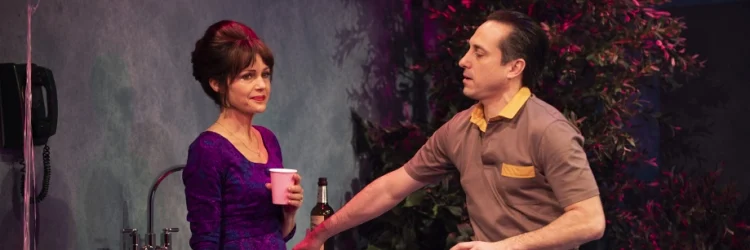Review of Anatomy of a Suicide at Atlantic Theater Company
The format of Alice Birch's Anatomy of a Suicide, currently enjoying its US premiere at the Atlantic Theater Company, has been described as experimental. Which surprises me since Ringling Brothers Barnum & Bailey has been using the three-ring circus format for over a hundred years now. Of course, the circus is not trying to provide a narrative or explore complex familial and societal relationships while Birch is.
And therein lies the rub. When you present an audience with three separate events to absorb at once, at the circus, whether you watch the lion-tamer or the dog act is purely a matter of personal preference and will not affect your understanding or enjoyment of the experience as a whole. It's quite a different matter when you are exploring the carryover implications of mental health problems on three generations of women in a small theater while three different stories are unfolding on stage at the same time.
Because no matter how good the writing and acting is - and make no mistake, Anatomy of a Suicide can lay claim to excellence in both categories - it is virtually impossible not to miss about a third of what's going on. When three scenes are unfolding on stage, which they are about 75% of the production, the most you can actively follow at once are two. And even then, you're going to miss some of the subtle nuances of what you have been able to absorb.
The three narratives unfolding throughout the play revolve around Carol (Carla Gugino), who is suicidal before she has her daughter and struggles to stay functional for the sake of her child, even undergoing electroconvulsive therapy (formerly known as electroshock therapy). Then there is Carol's daughter Anna (Celeste Arias) and her mental health issues as the unmoored daughter of a woman who she feels didn't love her enough to stay alive. And finally, there is Anna's daughter Bonnie (Gabby Beans) whose ability to connect to others emotionally and her life choices are completely shaped by the suicidal legacy of her mother and grandmother.
Unfortunately, I don't think director Lileana Blain-Cruz has done everything possible to provide intentional focus for the audience. Admittedly a difficult task when Birch has structured the play so that multiple events unfold simultaneously. What winds up happening is that focus is pulled by whatever scene is either the loudest or the closest to an individual audience member, not necessarily what is most important to the arc or understanding of the overall story. Both my guest and I missed different essential pieces of the story because our attention was on another part of the stage in a different scene when they were revealed.
All three principal women gave powerful performances, and the subject matter is compelling, but I left the theater feeling frustrated, feeling like I had missed too much to really grapple with the juicy bits I had been served.
(Photo by Ahron R. Foster)
WHAT THE OTHER CRITICS SAID
"Cleareyed, comfortless, often dazzling, like sun on ice, Anatomy of a Suicide follows three generations of women tethered to life by the thinnest possible filament. Staged simultaneously across three time periods — seemingly the 1970s, the 1990s, the 2030s — it explores, unflappably, the interior devastation that leads at least two of these women to take their own lives."
Alexis Soloski for New York Times
"The structure of the play is disorienting, at times even overwhelming. But Lileana Blain-Cruz's direction provides clarity amid the cloud of pain. The production is exquisitely timed and calibrated, from the precision of the actors' coordinated dialogue to the brief thaws of Jiyou Chang's glacial lighting and the eeriness of Rucyl Frison's sound."
Adam Feldman for Time Out New York
"The three stories take place concurrently, with overlapping dialogue that finds the actors repeating the same words but in very different contexts. You may find yourself dropping out of one narrative to follow another more closely, and then deeply regretting having missed something crucial in your self-imposed detour. There are more than a few moments where you'll want to hit the rewind button. Anatomy of a Suicide is a play that makes you work to sort out the details and put them in place. Paying attention has its rewards."
Robert Hofler for The Wrap
"Everyone toils away during Alice Birch's new play, Anatomy of a Suicide: The audience, which attempts to decipher three separate but interconnected storylines being depicted simultaneously; the actors, who display perfect, split-second timing as they deliver dialogue constructed with the complexity of a musical fugue; and most of all the British playwright herself, who has created this jigsaw puzzle of a theatrical event that seems less designed to convey its provocative themes than to illustrate her formalistic cleverness."
Frank Scheck for Hollywood Reporter
Originally published on
